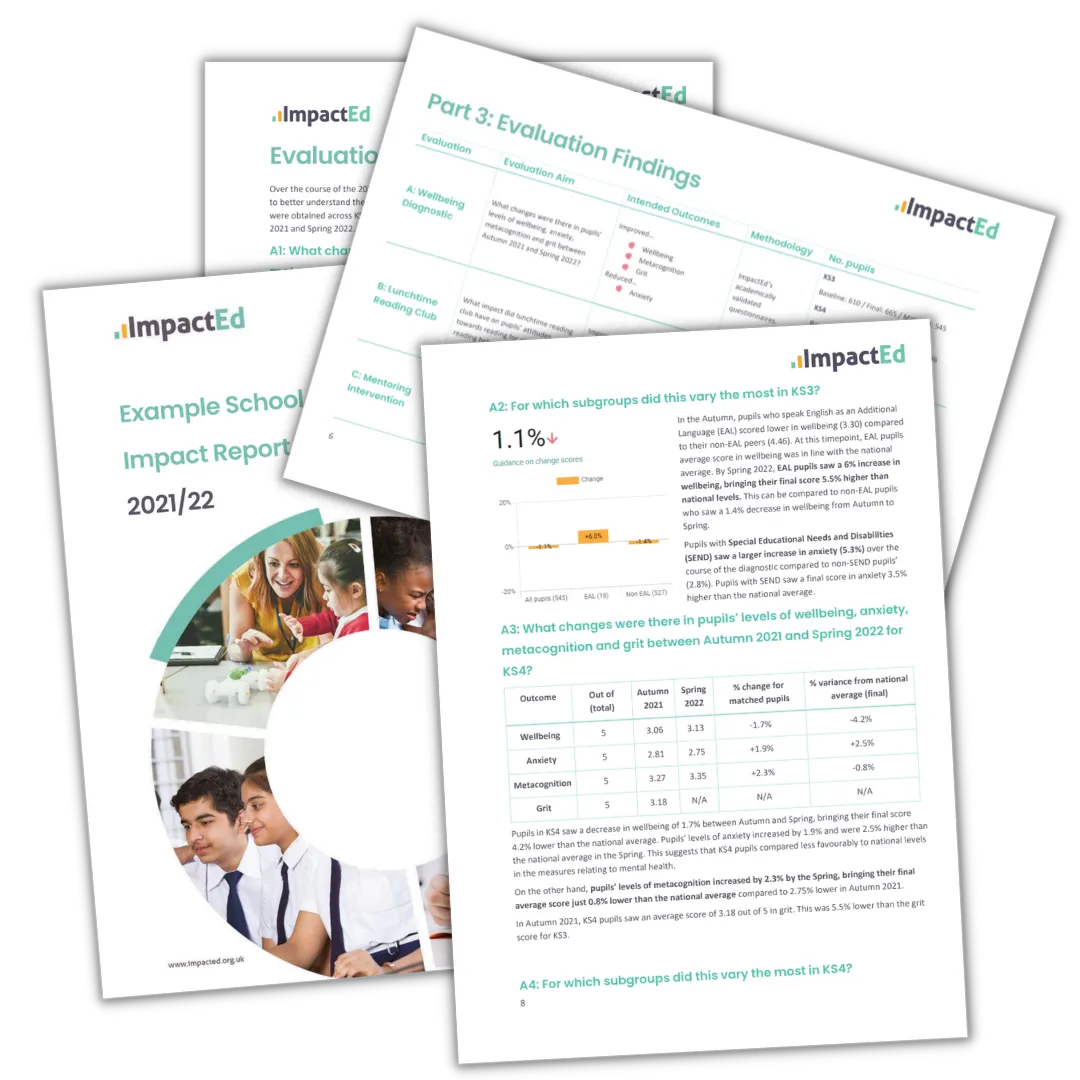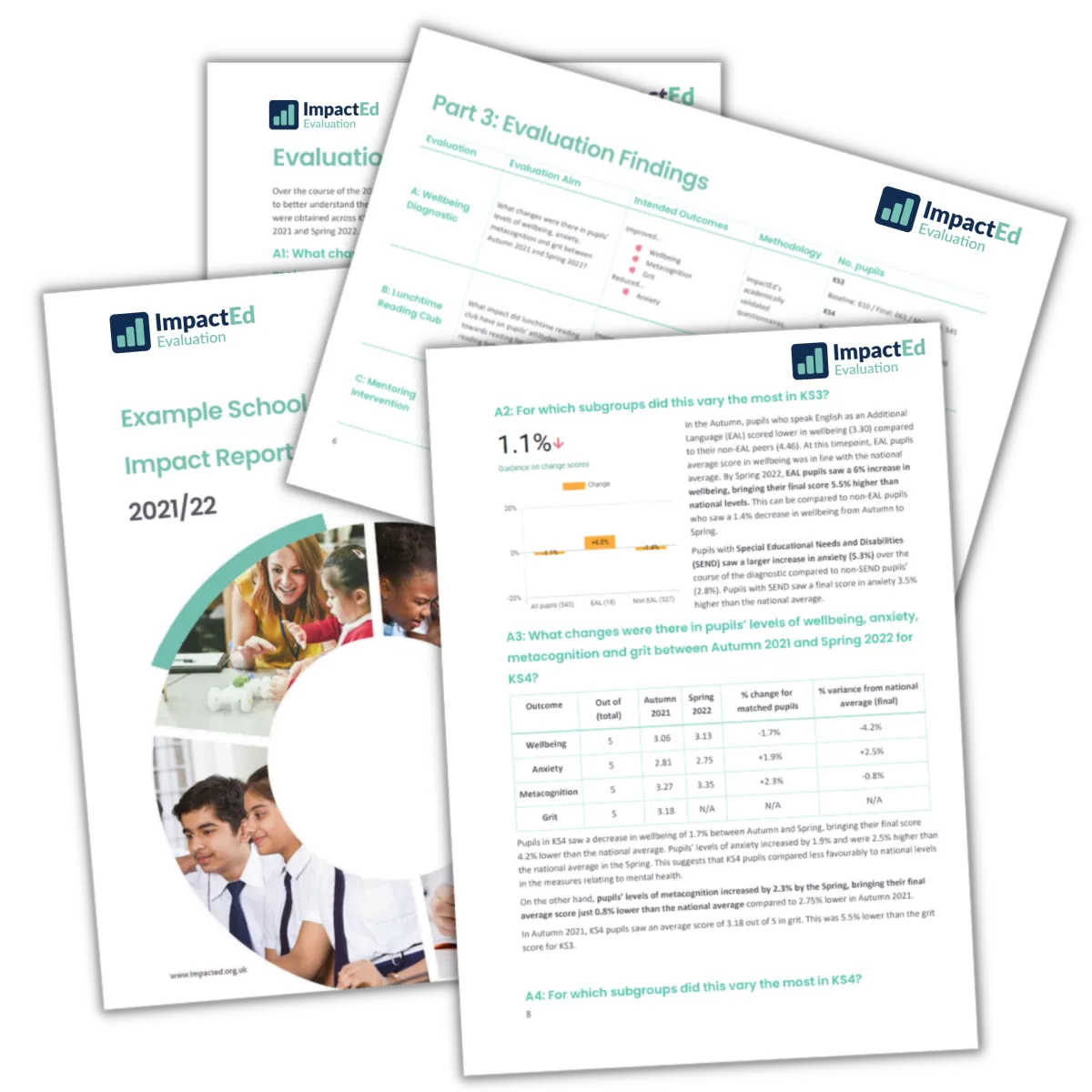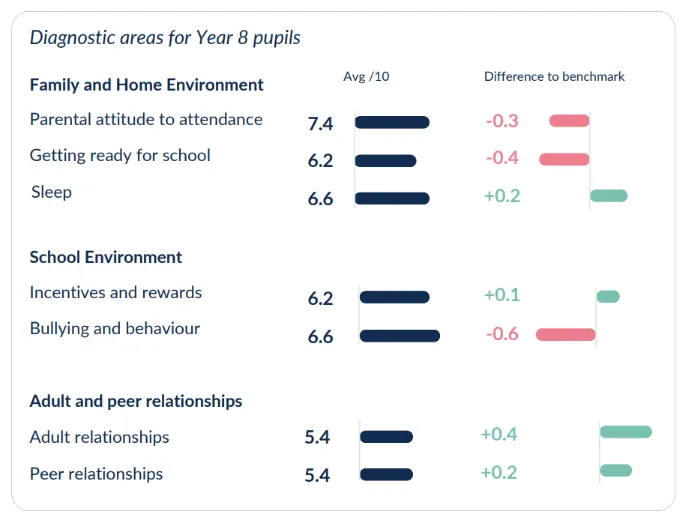
Helping schools, education and youth organisations have a positive impact on young people’s lives by enabling them to understand what’s working and do less of what isn’t.
Understanding
Attendance
Addressing the drivers of pupil absence with a robust diagnostic study
Discover the barriers to school attendance and the strategies you can put in place to improve outcomes for all your children. Use nationally benchmarked tools, access live reports, and receive 1:1 support with interpreting and using your data to inform next steps.

Understanding Attendance
Targeted research approach to improve pupil attendance
Understanding Attendance: From Insight to Action
In 2023 ImpactEd Group launched Understanding Attendance – a national research project reviewing attendance rates of over 300,000 pupils and surveys from over 80,000 young people throughout 2023/24 to understand the relationship between pupils’ social, emotional and behavioural measures and their attendance rates.
Our research to date has shed light on factors such as the importance of belonging and the second transition between Year 7 to Year 8. This evidence base has informed the development of a targeted question set and sophisticated approach to benchmarking. Schools participating in the project will use this to get deeper insight.


How have we developed the project?
Our research so far indicates that attendance is highly contextual. There are no quick fixes to pupil absence, and schools and trusts need tailored insights that helps them understand the drivers of attendance in their setting
With this in mind the updated version of the project has three major changes:
1. An updated question set – this focuses in more depth on areas such as sleep, parental attitudes, rewards and classroom behaviour, which are both actionable for schools and likely to be linked to attendance
2. Contextual benchmarking – with trends in attendance varying so much by a pupil’s year group and contextual circumstances, comparisons to national data alone can be limited. Our approach helps schools identify their relative high and low attenders, to better target their support.
3. Community of practice – the project will now be designed around regular census windows occurring across the country. Around these windows, and each half-term, regular network and practice sharing events will provide practical insights from school leaders and teachers.

Targeted research approach to improve pupil attendance
In a classroom of 30 children, six will miss at least one day of school every two weeks. That’s the reality for one in five children persistently absent across school classrooms in Autumn and Spring terms so far this academic year. This picture is worse for the most disadvantaged.
Focusing on transitions or belonging is vital, but we want to go further to help school leaders take
impactful action at a more granular level. This is why we are digging deeper with the next iteration of our research.
This next stage of Understanding Attendance is guided by three key insights:
• Age, stage and time - the importance of comparing like with like benchmarks
• A holistic view - challenges often arise when there is a disconnect between a school's intended actions and how they are perceived by various stakeholders. ImpactEd is delving into parents' views on attendance and will be sharing new insights on this soon.
• Playing the long game - although there are green shoots, the reality is attendance is a sustained effort requiring significant time, energy and resource. Cumulative attendance takes a long time to shift. But we have seen firsthand the value of celebrating the small wins and building positive momentum around attendance.

"ImpactEd Group's work shows the value of schools using data to understand the challenges children are facing and to scaffold necessary support. I welcome today's report which highlights some of the barriers which may prevent children from attending. This year, I am calling on everyone to make attendance their top priority."
Dame Rachel de Souza, Children's Commissioner for England

Your actionable attendance diagnostic
By taking part in this study, you will be able to:
Understand the drivers of pupils absence in your setting using nationally benchmarked tools
Select the measures most relevant to your setting to create short pupil-facing diagnostic
Access live reports on our platform
Interpret and use your data with our 1:1 support to inform next steps
We believe that, when done well, meaningful impact evaluation can help drive meaningful decision making to support you to do more of what is working best, and less of what is not!
"Persistent absence levels have increased over the last year. The School Impact Platform offers an opportunity to use social and emotional measures to gain fresh insights into the wider context of pupils across the school in order to gain an understanding of the influences and drivers behind this low attendance."
Mounts Bay Academy, Cornwall
Actionable insights to understand:
Adult & Peer Relationships, Family and Home Environment, School Environment
Our national diagnostic aims to provide targeted insights into factors affecting attendance. Using short pupil and parent facing questionnaires, the diagnostic reports on three domains – family and home environment, school environment, and adult and peer relationships.
• Collected through census windows up to once a term, results are contextually benchmarked against the most recent census so that you are comparing like with like throughout the school year.
• We integrate automatically with school management information systems, so that all diagnostic data can be accessed at individual level and by groups such as year group, gender, Pupil Premium and SEND.
• We also bring together the diagnostic with your attendance data, helping you to identify target groups compared to our national research cohort, and zooming in on the factors that affect your relatively lowest attending groups.
• We provide dedicated 1:1 support from a school partnership manager, who will hold review calls to help you interpret and act on your findings.
• The network includes optional half termly Understanding Attendance online network events, sharing real-life practice and examples.

Fill in the form to learn more about
Understanding Attendance
Fill in the form to learn more about our Understanding Attendance Diagnostic Study
Discover the barriers to school attendance and the strategies
you can put in place to improve outcomes for all your children.
Discover the barriers to school attendance and the strategies you can put in place to improve outcomes for all your children.
© 2025 - All Rights Reserved. Private limited company number 14266872.
58 Victoria Embankment, London EC4Y 0DS